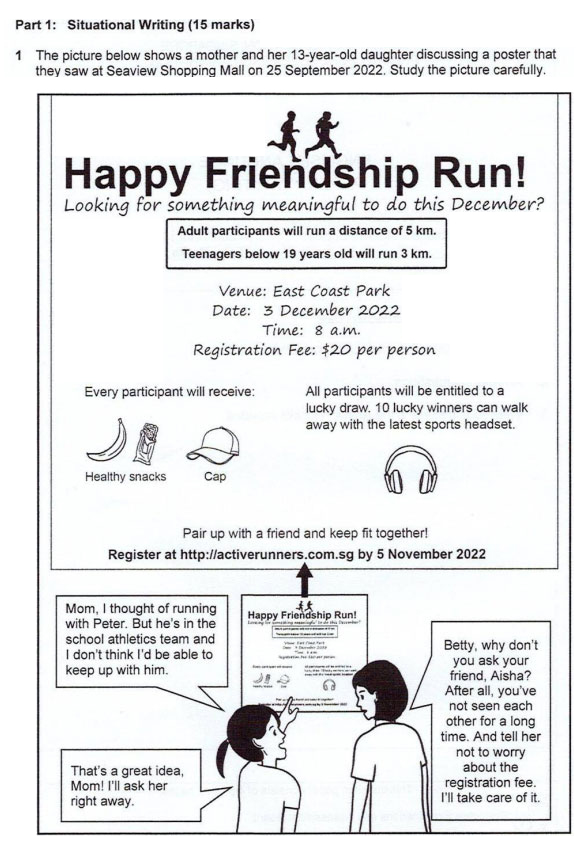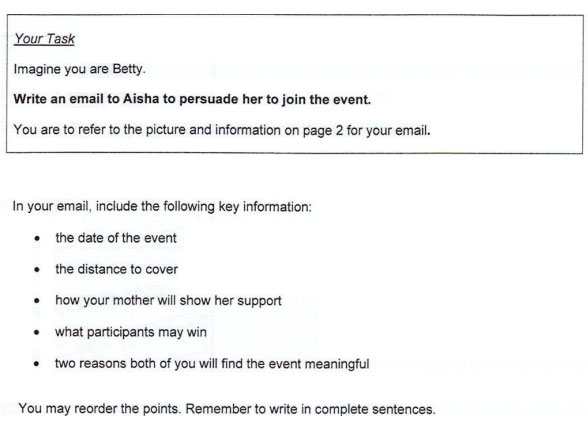The Situational Writing (SW) component is a component that is only introduced to students in their Primary 5 years. It is part of PSLE Paper 1 and is a total of 15 marks. SW is divided into Formal and Informal, with informal considered easier to score as it has fewer rules for students to remember.
Informal SW usually consists of writing an email or a letter.
For Formal SW, students may be required to write a letter, email, or report, with each format requiring students to remember a different set of rules. In recent years, SW Formal has become easier as students are only required to write an email, eliminating the formalities of a report or letter.
At the same time with these changes, different schools have different sets of rules for SW. For example, one school may accept ‘Cheers’ as a sign-off for Informal SW while another may penalise their students. Some schools require students to have only 3 paragraphs while another requires students to have one paragraph for each point or even no paragraphs at all.
So, with all these differences what is expected of PSLE SW?
Situational writing marking information
Marks for Situational Writing are given according to 2 criteria – Task fulfilment and Language Organisation
1. Task Fulfilment
Task Fulfilment is a total of 6 marks.
The information the student gives in the SW must be relevant and complete. In other words, the student is required to write all the relevant points required in the Task section.
The student needs to show clearly that he or she has understood the purpose, audience, and context. In other words, the student needs to show that he or she has understood if the SW is Formal or Informal, (audience) and use the correct Formal or Informal tone and rules in the SW (context). The student will also need to show clearly at the start and at the end of the SW the reason for writing it (purpose).
2. Language Organisation
Language and organisation is a total of 9 marks. On top of fulfilling the task, students need to make sure that they have no grammar and punctuation mistakes.
Having all the relevant and complete points (task fulfilment) is not enough. Students are also required to ensure that the points are well-linked and clear and concise.
So, while the Situational Writing component seems like the easier of the two in Paper 1, getting a full score without consistent practice is not an easy task. I have had students (who score within the 35 range for compositions), struggle to get a 13/15 for SW due to Language and Organisation. This is why we work on this component twice a month with our Primary 5 and Primary 6 students. With the new AL scoring system, this component can also be a great ally in helping students score their AL goal for English.
Now, that the expectations and scoring system are clearly mapped out, let us take a look at the PSLE 2022 Situational Writing Component.


3 steps to help you score well for the Informal Situational Writing component
At TF, we work on SW using the following steps:
Step 1 : Read the poster and information carefully
After reading the poster/ advertisement/ text, we summarise what we have read to ensure that students have fully understood the points read.
In this case, this is a poster about a Happy Friendship Run in December (school holidays).
Step 2 : Read the Task section and highlight the information asked
While this may seem easy, students can sometimes miss out on relevant points and this can cost them quite a few marks. Thus, I usually review with them the points that they have highlighted. Students are also required to be very clear on the audience, purpose, and context of the SW.
In this case, the audience is Aisha who is a friend (Informal). The purpose is to persuade her to join the run with you. While most of the points are straightforward, point 5 requires students to come up with two relevant reasons why Aisha and you will find the event meaningful. Students will be able to do this by looking at the dates and collecting information from the text. This is another reason why Step 1 – reading the poster carefully, is important.
Step 3 : Prepare an introduction and ending
Organising the relevant information will require students to think of a simple and concise way to start the email. In this case, telling the audience where you saw the poster and what it is about briefly is a good way to begin.
Remembering to mention the purpose of the SW at the end to show that you have clearly understood the purpose, is a good way to end.
When the students have completed the three steps, they can begin to write. Let us take a look at a possible model below for the 2022 PSLE SW. (Please take note that every school has its own set of rules for paragraphing and signing off so please ensure that your child follows his or her school’s set of rules).
Informal situational writing model
Dear Aisha,
(Introduction) I hope that you are doing well! I recently came across an interesting poster at Seaview Shopping Mall with my mother. The poster was about Happy Friendship Run and I am keen to sign up for this run. (Purpose) Would you like to take part in this friendship run with me?
(1) The run is on 3 December 2022 and it is held at East Coast Park. (2) As we are 13 years old, we only need to run 3km. (5) I think that this event will be meaningful for both of us as we have not seen each other for a long time and this event will be a great way for us to create new memories together. This event is also held during the December school holidays and the run will be a reason to get out and exercise together. (3) Aside from every participant receiving a cap and healthy snacks, we are entitled to a lucky draw and ten lucky winners may win the latest sports headset. (4) My mother thinks that participating together in the Friendship Run is a great idea and she has offered to pay for our registration fees.
(Ending) I hope that I have persuaded you to join this run with me! We will need to register online by 5 November 2022 so I hope to hear from you soon!
Regards,
Betty
Check the other articles from this section
- SOTA Primary 6 Creative Writing Competition 2021
- Phrases to describe pride and embarrassment
- P6 English Composition model: Being punished
- Creative Similes – How to use them and score in your PSLE compositions
- P6 2021 SA1 List of Composition Themes
- P6 Composition Being Late
- List of P6 2020 English composition Preliminary Themes
- List of 2018 PSLE Compo themes
- PSLE Composition Reminders
- Phrases to describe ‘A Narrow Escape’
- PSLE English 2022 Paper 1: Check what AL1 and AL2 English scorers wrote about
- List of 2022 Preliminary Themes
- 4 ways to score in the PSLE 2023 Composition & a Model Composition on the theme of ‘A change for the Better’
- List of 2023 Preliminary Composition themes & model on ‘kicking a bad habit’
- List of 2021 Preliminary Composition Themes
- PSLE English Composition tips: Two ways to plot ‘An unexpected discovery’ & model composition
- P6 English Composition: 3 ways to help students score above 33 for their examinations
- 2022 English Prelim and Composition Model – A change in attitude
- Primary 6 Composition A dangerous situation
- P6 Composition Theme Something Unexpected that Happened to You
- P6 SA1 2018 List of Composition Themes
- PSLE Composition A Crime you were involved in
- P6 Situational Writing
- PSLE English Composition Theme – A Considerate Act
- P6 Composition An Adventure
- 2019 Preliminary Composition Themes
- P6 English Composition A Secret
- P6 Model composition – A Dangerous situation
- Primary 6 English Composition: A Changed Behaviour & PSLE 2019 results
- P6 SA1 Composition Themes 2019
- P6 Writing: City Underground & SOTA Primary 6 Creative Writing Competition 2020
- P6 English: An unforgettable event composition
- P6 Composition A Memorable Occasion & taking risks in plots
- PSLE Composition Theme An Unusual Incident
- P6 Composition model on Achieving a goal & how to score well
- P6 English Composition model An Unwelcomed Guest
Don’t Miss Any Future Post!
2024 P6 English Tuition Timetable
| Branch | Day | Time |
|---|---|---|
| Bukit Timah | THU | 3 pm to 5 pm |
| Bukit Timah | THU | 5 pm to 7 pm |
| Bukit Timah | SAT | 1 pm to 3 pm |
| Bukit Timah | SAT | 3 pm to 5 pm |
| Hougang | WED | 5 pm to 7 pm |
| Hougang | FRI | 3.30 pm to 5.30 pm |
| Hougang | SAT | 1.30 pm to 3.30 pm |
| Virtual branch* | FRI | 5.30 pm to 7.30 pm |

